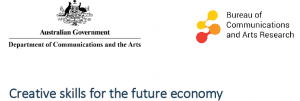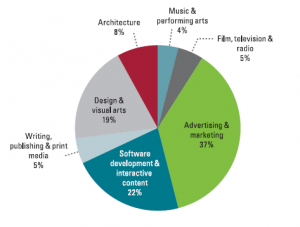
This file contains a selection of articles on the actual and potential value of crrative industries in Australia
Factsheet-1-Creative-Employment-overview-V5

The Creative Economy in Australia Factsheet [edited excerpt]
This factsheet is an output of an Australian Research Council Linkage project (LP160101724) led by Queensland University of Technology in partnership with the University of Newcastle, Arts Queensland, Create NSW, Creative Victoria, Arts South Australia and the WA Department of Culture and the Arts.
his factsheet presents an economic overview of cultural and creative activity in Australia, drawing on custom tables from theAustralian Bureau of Statistic’s Census collection.
Highlights:
- Employment in the creative economy represented 5.5 per cent of the Australian workforce in 2016
- Creative employment is growing at nearly twice the rate of the Australian workforce
- Creative industry incomes are on average higher than those in other industries, but their rate of growth is not keeping pace with the average earned by the Australian workforce
- On average, the creative industries provide employment to 1.5 times as many people in support roles as in core creative roles
5.5 per cent of Australians are in creative employment
In 2016, total creative employment accounted for 593,830 people, or 5.5 per cent of the Australian workforce, with 408,900 people employed directly in the creative industries.
In 2016, creative industries employed nearly 409,000 people, 3.8 per cent of the total Australian workforce. With more than 162,000 people employed in creative occupations (specialist creatives), the creative industries provide employment to 1.5 times as many people in support roles.
An additional 185,020 people working in creative occupations were employed—embedded—in industries other than the creative industries, including finance, government, hospitality, education and manufacturing.
Creative employment is a growing segment in the workforce. As a share of the Australian workforce, creative employment has increased from 3.7 per cent in 1986 to 5.5 per cent in 2016.
Growth in creative employment is nearly twice that of the Australian workforce. Between the 2011 and 2016 Census collections, creative employment grew by an average of 2.2 per cent per annum, nearly twice that of the
Australian workforce.
Victoria’s 2.9 per cent average annual growth between 2011 and 2016 is the highest of all the states and territories and is 2.5 times higher than the growth rate of its whole workforce at 1.2 per cent.
Creative employment remains concentrated in the ACT, NSW and Victoria. NSW’s rate of 1.9 per cent was 50 per cent higher than its workforce rate, while Queensland with a relatively low workforce growth rate of 0.6 per cent grew its creative employment at a rate of 1.6 per cent.
bcar-creative-skills-for-the-future-economy
This report contains an extensive analysis of projected impacts of automation in all sectors of the economy. It presents substantial evidence that non routine cognitive skills, particularly creativity and problem solving, are resistant to automation and will underpin employment growth areas.

Executive summary
New technologies are having, and will continue to have, a pervasive effect on the future of work. As a consequence, employment in digital-intensive industries has more than doubled over the past 30 years.
However, the effects are broader than just these industries. The majority of employment growth over that period has been in occupations that cannot easily be automated. This has seen an increase in what are termed ‘non-routine cognitive jobs’ which occur in fields such as education, healthcare, professional services, arts and design. This is also reflected in the growth of those employed in creative occupations, which grew at around double the rate of other occupations between 2011 and 2016.
As this trend continues, new employment opportunities are more likely to require skills which are resistant to mechanisation. Creative skills, requiring original thought and innovation, are particularly resistant and are likely to face relatively higher demand in the future. This paper contributes to the evidence base on the importance of creative skills for future economic outcomes.
A common misconception is that these skills are predominantly found solely in ‘creative’ fields, such as the performing and visual arts. In fact, 9.5 per cent of those employed in Australia in 2016—around a million workers—held a ‘creative’ qualification as their highest level of qualification. The most prevalent of these qualifications included:
• communication and media studies, graphic and design studies, visual arts and crafts and performing arts
• management and commerce, particularly sales and marketing
• information technology, including computer science
• architecture and building.
This underestimates the true prevalence of these creative skills. This is because the data includes formal qualifications (including vocational and non-award qualifications) not self-taught skills and ‘learning by doing’, which are essential to creators and creative industries.
Creative skills already have a substantial influence on the economy. Creative skills:
• Are critical to industries that provide inputs to produce a wide range of goods and services. In 2014–15, Australian businesses relied on around $87 billion worth of creative industries inputs.
• Have been integral to fast-growing industries over the past decade. Around a quarter of those employed in Information, Media and Telecommunications, and a fifth of those employed in Professional, Scientific and Technical services hold a formal qualification in a creative skill.
• Are significant in some innovation-intensive industries. Of the top five most innovation-active industries, between 10 and 28 per cent of employees hold a creative qualification.
• Support Australia’s participation in the global economy. The share of exports in what Australia produces that can be attributed to complete or partially creative industries is 4.5 per cent.
• Will be vital to future employment growth. Around one in seven workers currently in the industries projected to grow the fastest over the next five years holds a creative qualification.
As the trend to automation continues, so does the likelihood that expanding industries will rely on creative skills. Understanding their role and influence will be critical to positioning Australia to benefit fully from new technologies and sources of growth.
Valuing-Australias-Creative-Industries-Final-Report-December-2013_Email
Valuing Australia’s Creative Industries: Report of SGS Economics and Planning for Creative Industries innovation Centre, University of Technology, Sydney.
This report contains a profile and valuation of Australia’s creative industries
